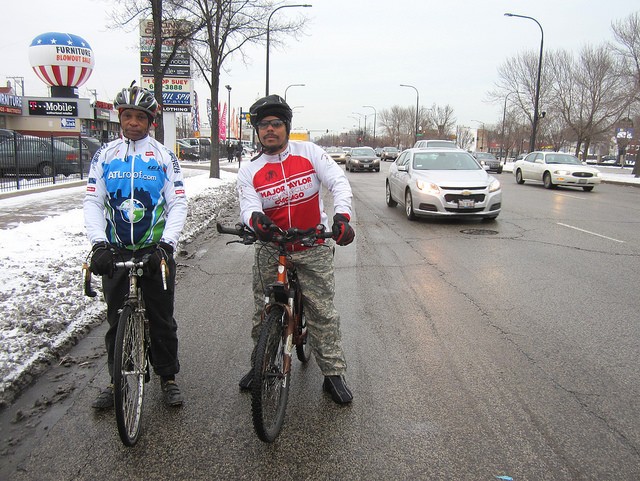
- JOHN GREENFIELD
- Cyclists Waymond Smith and Elihu Blanks on Stony Island near 74th Street
For much of its length, Stony Island Avenue is basically an expressway with stoplights. Located on the southeast side between 56th and 130th, it generally has eight travel lanes, the same number as Lake Shore Drive, although it carries half as many vehicles per day—35,000 versus 70,000. Due to this excess lane capacity, speeding is rampant.
The city has proposed converting a lane or two of Stony between 67th and 79th into protected bike lanes. Some residents, and Fifth Ward alderman Leslie Hairston, fear the “road diet” would cause traffic jams, and argue the street is too dangerous for bike lanes. Other neighbors say Stony is too dangerous not to have them.
According to the Chicago Crash Browser website, created by Streetsblog’s Steven Vance, 53 pedestrians and 16 bicyclists were injured along Stony Island between 67th Street (the southern border of Jackson Park) and 79th Street (where access ramps connect Stony with the Chicago Skyway) between 2010 and 2013.
Two pedestrians and a person in a car were killed in crashes on this stretch between 2010 and 2014, according to the Chicago Department of Transportation. Last year was unusually deadly, with two fatal pedestrian crashes and two bike fatalities.

- JOHN GREENFIELD
- The six-way intersection of Stony, 79th, and South Chicago, located below Skyway access ramps.
The complex intersection of Stony Island, 79th, and South Chicago, a diagonal street, is particularly problematic. Located beneath a mess of serpentine Chicago Skyway access ramps, the six-way junction has terrible sight lines. It was the site of 444 traffic crashes between 2009 and 2013, the most of any Chicago intersection, according to CDOT.
Adding protected bike lanes could change this equation, making Stony, among other things, a useful bike route. Due to the Skyway and other barriers like railroad tracks, cul-de-sacs, and a cemetery, it’s one of the few continuous north-south streets in this part of town.
The bike-lane plan has been around for almost a decade. In the mid-2000s, under Richard M. Daley, CDOT proposed installing the city’s first-ever protected bike lanes on the street. By December 2010 the city had been awarded a $3.25 million federal and state grant to build the lanes as part of the Stony Island Master Plan.
Ultimately Kinzie Street got the city’s first protected lanes in July 2011. Around that time the Illinois Department of Transportation began blocking CDOT from installing protected lanes on state-jurisdiction roads within the city, including Stony Island. The opening of curb-protected lanes on Clybourn last summer marked the defacto end of the moratorium.

- CDOT
- A CDOT rendering of one-way protected bike lanes on Stony Island. In this scenario, two mixed-traffic lanes would be converted to one-way bike lanes on opposite sides of the street.

- CDOT
- A CDOT rendering of Stony Island with a two-way protected bike lane
The department discussed two possible scenarios for the Stony protected bike lanes at public meetings in the Fifth, Seventh, and Eighth Wards in 2014, according to CDOT spokesman Mike Claffey. The first would convert two travel lanes to one-way bike lanes on either side of the street. The other would replace a single northbound travel lane with a two-way protected bike lane, as has previously been done downtown on Dearborn and Clinton.
But the 2014 community meetings didn’t go smoothly. According to DNAinfo Chicago, at a March 2014 meeting in the Fifth Ward, residents expressed doubt that cyclists would bike on Stony, and fear that the road diet would lead to traffic jams.
However, the plan may finally be moving forward. Last month at a Mayor’s Bike Advisory Council meeting, Mike Amsden, who manages CDOT’s bikeway program, said the project still has “a very good chance of moving forward” as a single two-way protected lane.
IDOT is currently coordinating with the city on the project, according to spokeswoman Gianna Urgo. “We are in the very early planning stages,” she said. “Nothing has been ruled out.”
There’s just one problem: Hairston, whose ward contains most of the project area, said last week that she’s against the plan. “The community was vehemently opposed to bike lanes on Stony Island,” she said. “If you take away travel lanes, it will cause congestion.”

- Fifth Ward alderman Leslie Hairston
In addition, Hairston claimed, residents feel that Stony south of 67th is too dangerous for biking. “The traffic speed on most of Stony Island does not lend itself to sharing the road with bikes,” she said.
However, bike advocates who live near Stony say it would be misguided for Hairston to block the bike lanes. “The idea that the street is too dangerous for bike lanes is something of a cop-out,” said Shawn Conley, a 41-year-old real estate investor. He’s the chair of the Major Taylor Cycling Club of Chicago, a mostly African-American group.
“It’s too dangerous to ride on right now,” Conley said. “But if they put safe, barrier-protected bike lanes on it, people would bike on it all the time.”
South Shore residents Waymond Smith and Elihu Blanks agreed. Smith, 63, is a retired printer who volunteers with Working Bikes Cooperative. Blanks, 39, is a banker who’s a member of Conway’s club and the Active Transportation Alliance.
Blanks argued that having more bike and foot traffic on the street would encourage economic development, including pedestrian-oriented retail. “And having more eyes on the street could help reduce the crime rate,” he added.
Smith believes some of the opposition is due to the misconception that south-siders and African-Americans don’t bike. Recently, when he was cycling to the store, a driver pulled up to him, rolled down the window, and said matter-of-factly, “We don’t do that on this side of the city—you’ll get killed out here.”
Blanks said he had a similar exchange with Eighth Ward alderman Michelle Harris at a recent ward meeting after he argued that motorists should be ticketed for driving in the bike lanes on South Shore Drive, located a mile or two east of Stony. “She said, ‘I don’t like that project—we don’t bike on this side of town.'”
Harris didn’t respond to interview requests.
“What gets lost in the conversation about Stony Island are the economic and health benefits of biking,” Smith said “In the black community, obesity, hypertension, and diabetes are huge issues.”
Hairston claimed the eight-lane street carries 60,000 vehicles a day, although that number is actually 35,000. Studies show that streets with two travel lanes plus a turn lane can handle up to 20,000 daily trips without congestion problems, which suggests converting one or two lanes on Stony wouldn’t cause carmageddon.
Smith and Blanks both hope CDOT can overcome the opposition and make Stony safer sooner rather than later. “Putting in bike lanes is not going to waste that much time for drivers,” Smith said. “Turn off the TV earlier and wake up a little earlier in the morning. Wheel of Fortune can wait.” v
John Greenfield edits the transportation news website Streetsblog Chicago.







